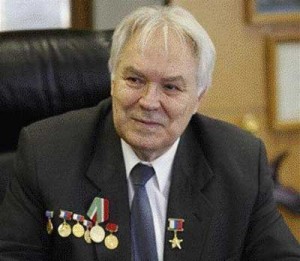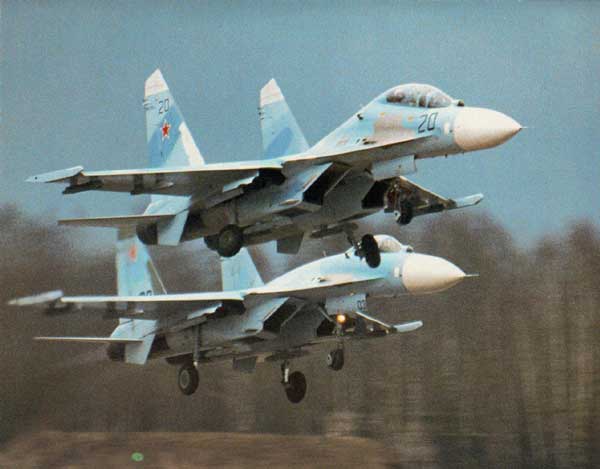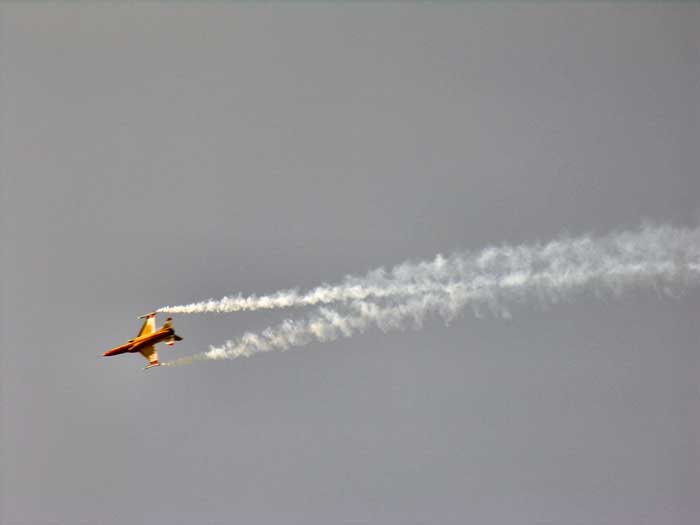By Dr. Richard Weitz
03/22/2011 – The famed Russian aircraft designer Mikhail Simonov died earlier this month, at the age of 81, after a long illness. His Sukhoi fighter jets represented the best of the Soviet defense industry and continue to dominate Russia’s arms sales to foreign countries.

Born in 1929 in Russia, Simonov began working as an aviation engineer in the 1950s. He joined the design bureau of the state-owned OAO Sukhoi aircraft corporation as the first deputy chief designer in 1970. During the following nine years he led the development of the Su-24 bomber, the Su-25 ground attack plane and began work on the Su-27. After serving as deputy minister of aircraft industries in 1979-1983, Simonov was named the top Sukhoi designer and continued work on the Su-27 Flanker. This plane—along with its later variants, the Su-30 air superiority fighter, the aircraft carrier-based Su-33, and the Su-34 bomber—was clearly Simonov’s most successful product.
The Su-27 was an agile long-range air superiority plane that entered the Soviet Air Force in the 1980s. It was designed as a highly maneuverable, well-armed twin-engine fighter capable of contesting the skies with the F-15, the premier U.S. Air Force 4th-generation fighter of the time.
The Su-27 could fly more than twice the speed of sound and more than 3,000 kilometers in distance. Perhaps only the rival MiG warplanes and the Kalashnikov assault rifle offered an equally prominent symbol of Soviet military power. The Su-27 always was a hit an air shows because its sophisticated control system allowed a skilled pilot to conduct stunning maneuvers at very low speeds. One stunt—called “the Cobra”—would involve the plane’s raising its nose and literally standing on its tail for several seconds.
During the lean days following the collapse of the Soviet Union in 1991, when the Russian government could not afford to buy more than a few warplanes each year, exports of Simonov’s Sukhoi planes helped generate the revenue needed to sustain the irreplaceable Sukhoi design bureau, its production facilities, and its education and mentoring system.
Sukhoi fighters still occupy a prominent role in the air fleets of China, India, and many other countries. Simonov received a Lenin Prize and two state prizes along with the Order of the Red Banner during the Soviet times. He was awarded with the Hero of Russia medal in 1999. He will be buried in Moscow’s prestigious Novodevichy cemetery.
 SU-27 Flanker (Credit: http://www.noahshachtman.com/images/Su-27-Flanker.jpg)
SU-27 Flanker (Credit: http://www.noahshachtman.com/images/Su-27-Flanker.jpg)
Simonov’s last major contribution to his company and country was his valiant attempt to develop a Russian fighter that could compete with the U.S. F-22 Raptor. Although the definition of a “fifth-generation” fighter is imprecise, it is generally agreed to have stealth (low-observable) characteristics, making the aircraft almost invisible to conventional radar. These include extensive use of composite materials, reduced engine heat signatures, internal weapons carriage, and other advanced technologies that minimize the aircraft’s optical, infrared, and radio-frequency visibility.
In addition, fifth-generation warplanes possess advanced integrated weapons, avionics, and navigation control systems that use state-of-the-art technology, such as artificial intelligence, to achieve enhanced maneuverability and network centric warfare capabilities. Furthermore, they can fly at sustained supersonic speeds (“supercruise”) of over 2,000 km/h. Most other planes can only attain such speeds for a limited time by using afterburners.
Russian aircraft makers have been seeking to manufacture such a fifth-generation warplane since the 1980s. The Sukhoi design bureau has been working on this project since April of 2002, when it won the tender as the prime contractor. In developing and manufacturing this plane, Sukhoi has functioned as a systems integrator for more than a hundred suppliers and strategic partners, a difficult challenge now that the centralize Soviet planned economy is gone, even in the defense sector.
Quality control at the level of sub-contractors has been a recurring problem challenging the reliability of Russian weapons systems. For example, poor components from sub-contractors likely explain the varied test performance of Russia’s new Bulava Submarine-launched ballistic missile. The Bulava has failed for different reasons in past tests, making it difficult for engineers to identify a single solution to its troubled performance.
With the Russian defense industry in disarray, Sukhoi could only field its fifth-generation plane some two decades after the U.S. Air Force began to acquire 5th-generation stealth planes. In January 2010, a pilot conducted a test flight of the T-50, the first Russian warplane entirely designed and built in Russia since the Soviet Union collapsed in 1991. The new warplane, of which the T-50 is a prototype, is formally known as the Advanced Front-Line Aviation Complex (PAK FA), [(Russian: Перспективный Авиационный Комплекс Фронтовой Авиации, Perspektivnyi Aviatsionnyi Kompleks Frontovoi Aviatsy, literally “Prospective (Promising) Aircraft Complex (System) of Front line Aviation”] Sukhoi manufactured it at a plant located at Komsomolsk-on-Amur in the Russian Far East, where the long-awaited January 2010 47-minute test run occurred.
It was only last week, on March 3, that the second T-50 model began flying its tests. A third T-50 prototype consists of an airframe being used for load testing on the ground. The first and second prototypes lack radar and weapon control systems, but the next two test aircraft, schedule to enter the program this year, will be fully functional.
According to Sukhoi, the T-50 has a new advanced avionics suite, a sophisticated phased-array radar, more automatic controls, and a very low radar cross-section. The new all-weather plane will be equipped with new high-precision air-to-air, air-to-surface and air-to-ship missiles and two 30 mm cannons in order to allow it to function in multiple roles, including dog fighting other planes and striking multiple ground and maritime targets simultaneously.
Russian defense analyst Konstantin Makienko asserts that the T-50, which borrows much equipment and techniques developed for Su-35S, would have less sophisticated features than the F-22. The Russian Ministry of Defense is still deciding whether to contract the development of a fifth generation engine. The T-50 prototypes are presently equipped with modified fourth-generation A-31FN engines built by the Saturn Corporation. These are more visible in the infrared range than desirable in fifth-generation plane. The Defense Ministry must decide whether to develop the fifth generation engine now, which will take 5-7 years, or defer its development for a completely different aircraft in the future. According to Makienko, modernized fourth-generation engines, build by “Saturn” and “Salut,” should be sufficient for the T-50 for several years until the plane grows in weight and sophistication.
 T-50 in Flight (Credit: http://data.primeportal.net/hangar/mu_yeol_lee/rokaf_t-50_golden_eagle/images/rokaf_t-50_golden_eagle_03_of_14.jpg)
T-50 in Flight (Credit: http://data.primeportal.net/hangar/mu_yeol_lee/rokaf_t-50_golden_eagle/images/rokaf_t-50_golden_eagle_03_of_14.jpg)
When the first T-50 enters service around 2015, it will be the Russian Air Force’s first all-new warplane since the Soviet Union’s collapse in 1991. Some analysts anticipate that the T-50 might not enter into service until several years later. But even the 2015 date would be several decades after the U.S. Air Force began operating similar fighters.
The T-50 is designed to compete with other fifth-generation fighter planes. In this class, only the U.S. Lockheed Martin/Boeing F-22 Raptor air superiority fighter is presently in operation. It conducted its first test flight in September 1997 and formally entered into service with the U.S Air Force in December 2005.The Lockheed Martin F-35 Lightning II multi-role fighter conducted its first test flight in December 2006. It is currently being developed with several international partners sharing their advanced aviation expertise. It will soon enter service with the U.S. Air Force, the U.S. Navy, and other possible clients.
The US Air Force expects to have 325 of its new F-35 Joint Strike Fighter by the end of 2016. By 2020, it will have about 850 5th-generation aircraft by 2020 when one includes the F-22s. Even China, whose best planes until recently consisted of Soviet-era Sukhoi’s purchased from Russia a decade ago, has developed its own J-20 stealth fighter. It is possible that China will soon have more 5th-generation planes than Russia.
The new T-50 planes will serve alongside the other new frontline warplane Sukhoi has recently provided the Russian Air Force, the Su-35s multi-role fighter. The Su-35 is considered a “four++” generation plane, with only some fifth-generation capabilities. The Russian government hopes to have 48 heavy Su-35S by 2015. The Russian Air Force plans to backload some of the new technologies developed for theT-50, especially the AESA Radar, as mid-life upgrades onto its existing Su-35BMs, Su-30MKIs, and Su-30MK2s. The military expects to receive 60 serially produced T-50 fighters between 2015 and 2020, but some independent observers expect that it will take several more years for the T-50 to enter into serial production. In any case, the integration of this new fighter into the Air Force will stretch out over a long period. Su-35 will remain the most advanced Russian aircraft for most pilots for the foreseeable future.
Until a few years ago, the Russian military aviation sector, like many other Russian defense firms, simply struggled to keep Soviet-era weapons platforms operational through upgrades of their computers or ordinance. The Russian military-industrial complex rarely produced any new complicated weapons systems. When it did, it would most often manufacture a few “prototypes,” but then resource constraints would prevent their “mass production.” Trying to “modernize” old airplanes, tanks and missiles that were designed in the 1970s and 1980s proved more costly and ineffective than anticipated.
In addition, Russian defense firms used to sell their most advanced weapons systems to wealthy foreign customers—who would pay in hard currency—before, and sometimes rather than, they would make them available to the cash-strapped Russian armed forces. During the 1990s, China, India, and other countries were able to buy more sophisticated aircraft than the Russian Air Force from Russian defense firms. Sales to foreign air forces still account for about a half of Russia’s annual arms sales, which amounted to $8.35 billion in 2008. Exports of Sukhoi systems account for about half of these, or one-quarter of the annual total.
Russian defense industry representatives have cited the development as demonstrating that the country’s military industrial complex had recovered from the period of post-Soviet collapse.
“This is a unique achievement for post-Soviet Russia, and we’re leaving Europe, China, and Japan far behind” in the race to build a fifth-generation fighter, says Alexander Khramchikin, an expert with the independent Institute of Political and Military Analysis. “This puts Russia at the top level in military development, and even higher.”
It will take a few more years before analysts can confirm that the Russian defense industry has fully recovered from the Soviet Union’s collapse.
In the interim, and as a bonus to SLD readers, I am relating a helpful list of Russia’s current air force bases that the scholars at the Center for Strategies and Technologies in Moscow have provided in their book, Новая Армия России (New Russian Army), published last year and available for free download on the internet (in Russian) at http://www.cast.ru/news/?id=403:
- Operational Strategic Command for Air-Space Defense (Moscow)
- 4th air-space defense brigade (Dolgoprudnyi, Moscow Oblast)
- 5th air-space defense brigade (Petrovskoe, Moscow Oblast)
- 6th air-space defense brigade (Rzhev, Tver Oblast)
- 6963rd aviation base (Kursk) (Mig-29SMT)
- 6968th fighter aviation base (Khotilivo, Tver Oblast) (Su-27, Mig-31)
- First Air Force and Air Defense Command (Voronezh) (Western OSK)
- 1st air-space defense brigade (Severomorsk)
- 2nd air-space defense brigade (St. Petersburg)
- 6961st aviation base (Petrozavodsk) (Su-27)
- 6964th aviation base (Monchegorsk, Murmansk Oblast) (Su-24M, Su-24MP)
- 6965th aviation base (Viaz’ma, Smolensk Oblast) (Mi-8, Mi-24)
- 7000th aviation base (Voronezh) (Su-24M, Su-24MP, Su-34)
- Second Air Force and Air Defense Command (Ekaterinburg) (Central OSK)
- 8th air-space defense brigade (Ekaterinburg)
- 9th air-space defense brigade (Novosibirsk)
- 10th air-space defense brigade (Chita)
- 6977th aviation base (Perm) (Mig-31)
- 6979th aviation base (Kansk, Krasnoyarskii Krai) (Mig-31)
- 6980th aviation base (Cheliabinsk) (Su-24M)
- 6982nd aviation base (Domna, Zabaikalskii Krai) (Mig-29)
- Third Air Force and Air Defense Command (Khabarovsk) (Eastern OSK)
- 11th air-space defense brigade (Komsomolsk-na-Amure)
- 12th air-space defense brigade (Vladivostok)
- 6983rd aviation base (Vozdvizhenka, Primorskii Krai) (Su-25, Mi-8, Mi-24)
- 6987th aviation base (Komsomolsk-na-Amure) (Su-27SM)
- 6988th aviation base (Khurba, Khabarovsk Krai) (Su-24M, Su-24M2, Su-24MR)

